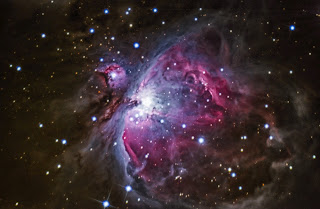The Orion Nebula (M42) is a stunning astronomical spectacle located about 1,500 light-years away from Earth. It is one of the most well-documented nebulae, thanks to its relative proximity and brightness, making it an excellent subject for both professional and amateur astronomers.
Historical Significance
Historically, different civilizations held unique interpretations of the Orion Nebula. The Maya of Mesoamerica likened it to the cosmic fire of creation. This association is quite apt, considering the nebula is an enormous cloud of dust and gas where vast numbers of stars are being forged.
Scientific Overview
The Orion Nebula is a diffuse emission nebula, signifying that it's a region of ionized gases emitting light of various colors. Its bright, central region hosts four massive, young stars that shape the nebula. This quartet of hefty stars is collectively called the Trapezium due to their trapezoidal pattern.
Stellar Formation
The Orion Nebula serves as a stellar nursery, offering an excellent peek at stellar birth. Ultraviolet light released by the massive stars in the Trapezium is carving a cavity in the nebula. This process disrupts the growth of hundreds of smaller stars, offering a unique insight into the ongoing process of star formation.
The Trapezium Cluster
The Trapezium Cluster, situated in the heart of the nebula, is an essential aspect of the Orion Nebula. The cluster's four bright stars emit ultraviolet light that carves through the nebula's core, creating cavities void of thick clouds of gas and dust. This large chasm enables observers to peer deep into the nebula's heart, witnessing the rich tapestry of star formation within.
The Orion Nebula Through the Lens of Hubble
The Hubble Space Telescope has captured some of the most detailed images of the Orion Nebula, offering the sharpest view ever obtained. The images are a composite of over 520 different Hubble exposures taken in multiple wavelengths of light.
The Orion Nebula in Different Wavelengths
Each wavelength reveals different features of the nebula. The orange color in the nebula is attributed to hydrogen, green represents oxygen, and red represents both sulfur and infrared light observations.
Observational Tips for the Orion Nebula
The Orion Nebula can be observed with the naked eye from a dark sky site, but binoculars or a telescope can provide a more detailed view. To locate it, find the constellation Orion and its easily identifiable belt. The nebula appears as a fuzzy patch just below Orion's belt.
Photographing the Orion Nebula
For astrophotographers, the Orion Nebula is a popular subject. Even from locations with moderate light pollution, long exposure photography can reveal the nebula's vibrant blues and pinks, showcasing the breathtaking beauty of our Universe. However, capturing its many colors requires the right camera filters and image processing techniques.
The Orion Nebula in Culture and History
Various cultures, from the Maya to modern-day astronomers, have marveled at the Orion Nebula's beauty and significance. It serves as a reminder of our place in the cosmos and continues to inspire awe and curiosity in all who gaze upon it.
Conclusion
The Orion Nebula is more than just a celestial object; it's a testament to the universe's dynamism and grandeur. Whether you're an amateur stargazer or a seasoned astronomer, the Orion Nebula offers an unparalleled opportunity to witness the cosmic dance of star birth and evolution.


I've been in awe ever since my mother showed me when I was little. With the telescope 🔭 and without!!!
ReplyDeletePost a Comment